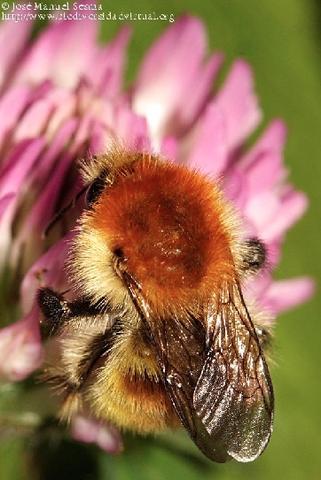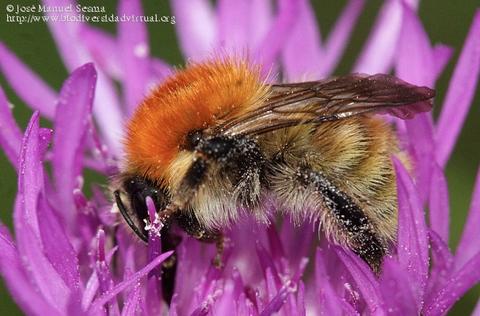Bombus pascuorum
Middle-small size.
Females: 15-18 mm.
Males: 12-14 mm.
Orange general coloration, which varies depending on the subspecies.



It has not been evaluated.
No threats described.
Females: elongated head. Malar space longer than distal width, as A 3+5, but smaller than A 2+3+4.
The sculpture of the malar space is fine, with homogeneous and nearby pits. Clypeus longer than the distal width too, which is prominent and has a slightly dotted disk. Well defined apical impressions, with a dense dotted. Flattened labral tubers.The labral groove is narrow at the base, but it widens in the distal region. Bright labral lamina, with a sharp edge. Front, under the ocelli, with a bright area and big pits. On the hind legs, the tibia has very sharp posterodistal angle; the basitarsus has short and isolated hairs. T5's dotted is fine and with separated pits. T6 is granulated. E6 has a distal keel.
Genitalia: wide external projections of the sting case's. Narrow internal projections.
Males: moderately elongated head, malar space similar to A 3+4. Long and dense mandibular beard. Thickened antennal flagella, asymmetric in the lower region. A3 longer than its distal width, but smaller than A5. Middle basitarsus with parallel sides. On the hind legs, convex, bright and hairless tibia; basitarsus with the posterodistal angle acute.
Genitalia : simple sagittae, sawn in the lower region. Stipes with the apex slightly protruding towards the inner zone. Wide escuamas with a curved and narrow ledge to the center. C-shaped volselas pubescent on the inner edge,
Bombus pascuorum is a widespread and common Western Palaearctic species. The noun form is located in Central Europe and Italy. It is also a very polytypic species with numerous subspecies (24, only about 16 Eurpoa) and hybrid in the overlapping populations.
Its distribution in the Iberian Penninsula is, depending on the subspecies, Central Iberian, northeast and northwest.
Potential distribution map at the present time
Potential distribution map in 2050 with the same level of pollution emission and the climate changes consequence of these contamination levels
Map legend
Maps are made with GBIF data of this specie in Iberian Peninsula
Emergence of queens : March.
Surface nest, between the vegetation.
colonies with numerous individuals.
Flight period: late March-October.
Bombus pascuorum has been collected in Fabaceae, Salicaceae, Boraginaceae, Rosaceae, Oleaceae, Asteraceae, Lamiaceae, Escrophulariaceae, Onagraceae, Dipsacaceae, Ranunculaceae, Plantaginaceae, Malvaceae, Iridicaceae, Verbenaceae, Ericaceae, and exotic species of gardes.
Biotopes: meadows of Fabaceae, gardens and orchards. In open areas and in forest.